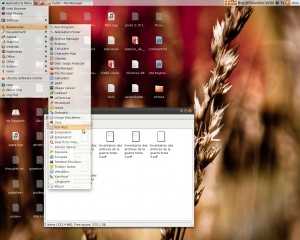
In the last month, my search for a sufferable desktop environment in the wake of my Unity and GNOME Shell disappointment has led me to try a lot of things I never had the patience for before, such as compiling one alternative interface from source. It’s also inspired me to revisit Xfce, a desktop environment I’d once sworn off but which is suiting my tastes more and more these days. I may even end up a Xubunter. Here’s why:
I’d experimented extensively with Xfce in days gone by when I was looking for a lightweight desktop environment to run on older hardware. But I was never particularly impressed because, as one articulate reader put it best in comments on a post a couple summers back, Xubuntu always felt like “Ubuntu’s cousin that went on a diet to be light, but decided to quit halfway through the diet.” It never appealed to me as a truly resource efficient interface.
I also always thought the default Xfce screen configuration was pretty poorly thought out. The thick upper panel and the dock-like contraption on the bottom of the screen sucked up a lot of valuable pixel real estate for no clear benefit.
How I Learned to Stop Worrying and Love Xfce
But they say happiness is relative, and my decidedly bad experience with Unity and GNOME Shell, which have superseded the tried-and-true GNOME 2 interface I knew and loved for most of my years as a Linux user, made Xfce seem like a much more appealing option once again. This time, I wasn’t so worried about resource efficiency, since my current hardware is up to much greater tasks than the tired old machines I owned a few years ago. I just wanted an interface that worked well.

So I installed the Xfce4 package on my Ubuntu 11.10 system to see if it just might make me feel at home again. And it did! But not out-of-the-box, of course — I made the following customizations:
Deleted the bottom dock and shrunk the upper panel down to about 24 pixels.
Changed the font to 9-point Verdana and enabled anti-aliasing, which improved the aesthetics dramatically on my LCD screen.
Replaced metacity with compiz for the window manager so I could enjoy desktop effects.
Installed Synapse, a neat little tool that offers pretty much everything Unity’s dash does, without the bugs.
There are still a few things in Xfce that irk me — for example, I can’t figure out how to stop it from displaying autosave files whose names end with a tilde on the desktop, an issue which seems unlikely to be resolved because it’s stuck in it’s-not-a-bug-it’s-a-feature land. But overall, Xfce has been a pleasure to use after feeling like a desktop environment refugee in the time since GNOME 2 ceased being a real option.
I may even decide to give up on Ubuntu and switch to its ostensibly lightweight cousin Xubuntu, just because Xfce app integration would be simpler there. Or maybe I’ll try Fedora’s Xfce spin or Zenwalk. First, though, I’ll probably play with a few other alternative desktop environments, such as LXDE, to see how they stack up against all the others I’ve thrown around recently.
For the time being, though, I’m just happy to be running a well-maintained interface that wholeheartedly embraces the traditional desktop metaphor on which I was raised, tired and boring as it may be. I like my panel, my alt-tab application switcher and my freedom to disable hardware acceleration if I feel like it. I even like the little Xfce mouse. Things are finally starting to feel right in my computer-world again.
About the Author(s)
You May Also Like


